Need help? Want a travelling buddy or advice about a place or country – want to share something with us – why not visit our Mutual Aid section of the Website: Mutual Aid
Tag Archives: April 2005
Nova Esperanca or New Hope by Tony Annis
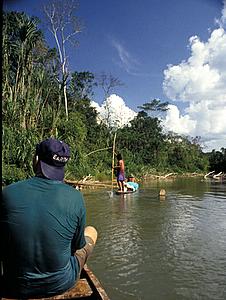 Mistake, mistake, mistake – How could I have made such a stupid
mistake. At our late lunch stop I had changed from boots to
sandals, strong sandals, the problem was not with the footwear but
with my brain which seemed to have gone into non thinking mode as
the day started to turn to twilight. We had been walking fast,
through thick rain forest and crossing and re-crossing rivers or
maybe even the same river. The last few Kilometres of the twenty
seven from our jump into the jungle to the 'Yawanawa'
village, our guides had decided to make what was a two day trek
into one. Why? I have no idea, unless it was too see how we would
make out. My legs felt like lead pillars as I walked in the river
my sandals acting like buckets holding my down feet, like walking
in treacle, my heart pounded loudly with each stride as I tried to
keep up with 'Yawanawa' Indian ahead, who was starting to
disappear in the dusk. The tribe had warned us that the rain forest
was very dangerous at night and they would always be back in the
village by nightfall! Just as I thought I could go no further and
dusk started to turn to darkness, I saw a figure on the shore about
a hundred metres away waving me on. I staggered up to Adam Baines,
for that's who it was, as he said “Well done Tony we have
made it” and we shook hands. Months of politicking in the
urban jungle, then many adventures on the way to our final
destination, the 'Yawanawa' village of Novo Esperanca – At
last we had arrived or nearly, the last hurdle or just about the
last straw, was about seventy steps cut in to the steep river bank
leading up to the village.
Mistake, mistake, mistake – How could I have made such a stupid
mistake. At our late lunch stop I had changed from boots to
sandals, strong sandals, the problem was not with the footwear but
with my brain which seemed to have gone into non thinking mode as
the day started to turn to twilight. We had been walking fast,
through thick rain forest and crossing and re-crossing rivers or
maybe even the same river. The last few Kilometres of the twenty
seven from our jump into the jungle to the 'Yawanawa'
village, our guides had decided to make what was a two day trek
into one. Why? I have no idea, unless it was too see how we would
make out. My legs felt like lead pillars as I walked in the river
my sandals acting like buckets holding my down feet, like walking
in treacle, my heart pounded loudly with each stride as I tried to
keep up with 'Yawanawa' Indian ahead, who was starting to
disappear in the dusk. The tribe had warned us that the rain forest
was very dangerous at night and they would always be back in the
village by nightfall! Just as I thought I could go no further and
dusk started to turn to darkness, I saw a figure on the shore about
a hundred metres away waving me on. I staggered up to Adam Baines,
for that's who it was, as he said “Well done Tony we have
made it” and we shook hands. Months of politicking in the
urban jungle, then many adventures on the way to our final
destination, the 'Yawanawa' village of Novo Esperanca – At
last we had arrived or nearly, the last hurdle or just about the
last straw, was about seventy steps cut in to the steep river bank
leading up to the village.
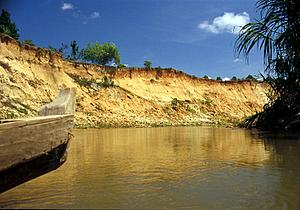 The 'Yawanawa' were early risers, the queue for the
bathroom or in this case the river started at 0415 hours for the
women and then the men from about 0445 hours. Breakfast consisted
of something from the day before, usually highly salted and
difficult to keep down as the sun started to kiss the village roofs
of the 'Yawanawa'.
The 'Yawanawa' were early risers, the queue for the
bathroom or in this case the river started at 0415 hours for the
women and then the men from about 0445 hours. Breakfast consisted
of something from the day before, usually highly salted and
difficult to keep down as the sun started to kiss the village roofs
of the 'Yawanawa'.
Adam and I stayed in the village main
hut, a sort of Pub with no beer or village hall, were the tribe met
either to eat with the chief or discus tribal policies or problems.
This hut had one large interior room with a double bed and a
hammock, I had the hammock after a discussion that I'm not sure
if I won or lost!? There was also a kitchen, or should I say a
small room that contained a medium size gas bottled refrigerator,
used if any medicine had been air dropped to the tribe and needed
to be kept cold and a large jug of water with a tin bowl.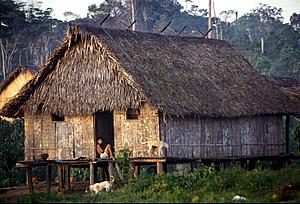 We had a
special treat one night, when the chief switched the fridge on for
a couple of hours and we had a mug of cold water that tasted as
good as any cold beer I have ever tasted.
We had a
special treat one night, when the chief switched the fridge on for
a couple of hours and we had a mug of cold water that tasted as
good as any cold beer I have ever tasted.
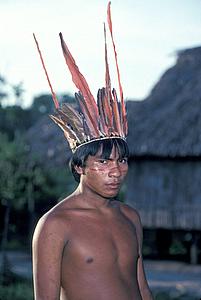 These Indigenous people had five different ways of sustaining
themselves,' in the depth of this green paradise.
These Indigenous people had five different ways of sustaining
themselves,' in the depth of this green paradise.
The hunters split the area around the village into seven parts and one part was never hunted on for seven years. They hunted and ate, monkeys, deer, wild pig, various birds and some things I did not want to know the name of. Fruit and fish were also part of their main diet. These people were just about to experiment with having one field for various vegetables.
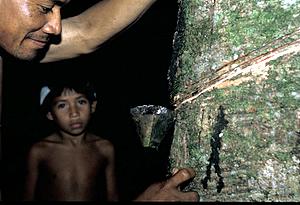 The two ways they made some money was with 'Aveda', a
Canadian firm that bought Uruku off the 'Yawanawa' for the
making of their expensive and famous make up, sold in top shops
like 'Harvey Nichols' both here, France and in North
America. The second way was with tapping the rubber and making it
into a sort of vegetable leather used in bags of all types and also
sold in quality shops in the worlds fashionable capitols.
The two ways they made some money was with 'Aveda', a
Canadian firm that bought Uruku off the 'Yawanawa' for the
making of their expensive and famous make up, sold in top shops
like 'Harvey Nichols' both here, France and in North
America. The second way was with tapping the rubber and making it
into a sort of vegetable leather used in bags of all types and also
sold in quality shops in the worlds fashionable capitols.
 The children had half a day of school and half a day of learning
how to work like their parents, in whatever was their speciality.
The best hunters or fisherman got the best and most desirable woman
as wives. I asked why no one seemed to wear glasses or have bad
hearing? – The answer was simple nobody would marry anyone with
those problems and therefore they were bred out – Survival of the
fittest! Adam's words echoed round my brain, “Lucky you
were born in London Tony”.
The children had half a day of school and half a day of learning
how to work like their parents, in whatever was their speciality.
The best hunters or fisherman got the best and most desirable woman
as wives. I asked why no one seemed to wear glasses or have bad
hearing? – The answer was simple nobody would marry anyone with
those problems and therefore they were bred out – Survival of the
fittest! Adam's words echoed round my brain, “Lucky you
were born in London Tony”.
 The money the village made enabled them to have huts made out of
planks but in the same traditional design but better fitting than
the log version.
The money the village made enabled them to have huts made out of
planks but in the same traditional design but better fitting than
the log version.
The tribe lived by some simple rules of the live and let live sort. Laziness was a major sin because it let down a people that had to pull together to survive. Daime was taken once every six weeks, the drug that keeps your head in order, or tidies the files of your mind. The last execution had been fifty years ago and everyone in the tribe had to watch over the age of twelve. The idea being, that when the 'Yawanawa' voted the death sentence, the tribe would know the horror of execution and think carefully before voting for death.
These people gathered on the large veranda of the main house in the evening to eat with the chief, play cards on the only table in the village, with a solitary candle lighting the game. Saturday night would be dance night and they would dance until dawn of the next day. A ghetto blaster run by a car battery, (that had been charged by a solar panel), in one of the huts again lit by one candle, would explode sound into the night frightening off any sort of animal, reptile or even insect far away from the village.
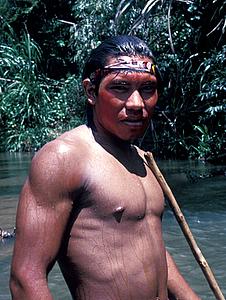 Antonio looked after the canoes and water transport; the tribe
would have its own specialists just as we do in our world. The
Chief himself would deal with the outside world business. The
Marriage with outsiders was not encouraged, The 'Yawanawa'
did not want Aids to in filter the village and also when a non
Indian married one of their girls, they tended to take the bride
out of the tribal area to live.
Antonio looked after the canoes and water transport; the tribe
would have its own specialists just as we do in our world. The
Chief himself would deal with the outside world business. The
Marriage with outsiders was not encouraged, The 'Yawanawa'
did not want Aids to in filter the village and also when a non
Indian married one of their girls, they tended to take the bride
out of the tribal area to live.
As the time came to leave this green paradise, I thought had it been worth all the problems in the urban jungle, difficulties of permissions, of hopes being raised and dashed and then raised again. The answer of course was a big yes. Staying with 'Yawanawa' even though for a short time taught me so much not just about the tribe but about myself as well. Everything is possible, with determination, tenacity, time and a belief in yourself, even when others say that your idea is impossibility.
Tanzania Game Hunting
The villagers of Ngarambe, bordering the Selous game reserve in Tanzanian had been allowed to sell hunting licences and shoot animals for meat so they would no wild animals would not destroy crops or menace the villagers. The area is rich in wildlife of all types – elephants, lions, giraffes, buffaloes and more. The government has said that the community can no longer hunt on this land or sell hunting licences to residents – instead a five-year hunting licence has been sold to a private company. According to BBC news, selling hunting permits is big business – trophy fees in the 2004 season ranged cost $4,000 for an elephant, $2,000 for a lion to $600 for a buffalo.
Been to Airlie Beach?
I am writing a book about a little known but stunning town in Australia called Airlie Beach. I am desperately seeking globetrotters who have visited this region. I am seeking submissions from them based on their time and experiences in the region.
Did Airlie Beach make an impact on your life? It’s the kind of place that is, ‘Once seen, never forgotten.’ I am looking for submissions from people, of all walks of life, on their favourite Airlie Beach experience. Everybody who has been there has one.
As a long time local, I have countless priceless memories, and nobodies amazing memories should be forgotten. Whether it is a funny anecdote, a poem you were inspired to write, a crazy story you heard, a picture of paradise you just can’t forget.
I am publishing a book and will consider: stories, poems, e-mails, snatches of conversation, diary entries, day in the life of, family history, dreams, artwork, photos, drawings etc.
Please contact me on: airliebeachkatie@yahoo.com.au
The Borobodur, Indonesia
Last December, the Beetle visited Indonesia. Apart from diving I took a trip to Java from Sulawesi and saw the Borobodur Temple (amongst other things). I stayed a few days in Yogyakarta, a name I shall forever have problems pronouncing and hired a car and driver for US 30 for the day which seemed a pretty efficient way of getting around. Much to the initial annoyance of my driver, we gave lifts to anyone (especially older people) carrying huge bundles and had the freedom to stop wherever I fancied and see out of the way things, and some really were out of the way! Mr Azim, my very patient driver looked after me well, as well as driving like he was trying to break the world land speed record and he made Yogyakarta to the Borobodur in just 40 minutes! Using public transport, it is possible to go by bus or minibus from Yogyakarta to the town of Muntilan, change at the terminal here to another bus for Borobudur. Note that the bus station at Borobudur is 1km away from the temple though it is possible to walk. Alternatively, you can go on one of many guided tours on mini buses to Yogyakarta.
It seemed to be the time of year when schools make their annual school trip outings. There must have been several hundred school children, lounging around, larking about, and taking lots and lots of photos! I found out, by talking with many of the groups that they came mainly from Sumatra and other parts of Java and they were absolutely delightful, as curious about me as I was about them. I got many tips on places to go on my travels and invites to family homes, which was very kind.
This was just one day after the horrific tsunami and there was a muted respect and appreciation for the events that were just starting to unfold, but at the same time, it was a holiday and the school children were having a whale of a time.
The Beetle was pretty much the only non Indonesian visitor on that day and the school children's main task seem to be to detract me from seeing the Borobodur at all, but I didn't mind. It was a lot of fun lining up, arms round the girls' shoulders, smiling broadly for the multitude of cameras that were bought out, just one more, just one more they'd say. And the boys, shyly jostling to see who could stand closest and arms held just above my shoulders, thinking I would not see them or feel them as long as they were not resting on me. They were funny adolescent youngsters. And then there was the name and signature signing in their little notebooks. I thought the whole thing was most odd, but a wonderful way to meet Indonesian people and my entire 4 hours spent there consisted of photo posing, though I got my own back and asked other people to pose for me, notebook signing and having simple English conversations. It was a lot of fun, though I kind of wished I'd had a little more of a chance to see a bit more of the Borobodur!
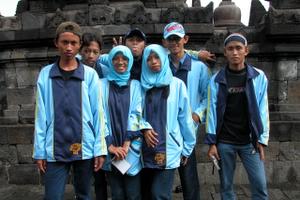
Ok, about the Borobodur: It is thought to have been built between
the end of the seventh and beginning of the eighth century A.D. For
about a century and a half it was the spiritual centre of Buddhism
in Java and then it was lost until its rediscovery in the
eighteenth century. The temples are set in beautifully manicured
gardens and are said to be composed of 55,000 square meters of
lava-rock is erected on a hill in the form of a stepped-pyramid of
six rectangular storeys, three circular terraces and a central
stupa forming the summit. The whole structure is in the form of a
lotus, the sacred flower of Buddha. For each direction there are
ninety-two Dhyani Buddha statues and 1,460 relief scenes. The
lowest level has 160 reliefs depicting cause and effect; the middle
level contains various stories of the Buddha's life from the
Jataka Tales; the highest level has no reliefs or decorations
whatsoever but has a balcony, square in shape with round walls: a
circle without beginning or end. Here is the place of the
ninety-two Vajrasattvas or Dhyani Buddhas tucked into small stupas.
Each of these statues has a mudra (hand gesture) indicating one of
the five directions: east, with the mudra of calling the earth to
witness; south, with the hand position of blessing; west, with the
gesture of meditation; north, the mudra of fearlessness; and the
centre with the gesture of teaching.
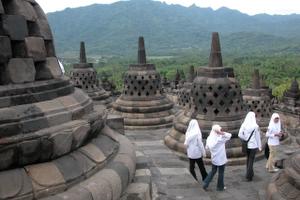
You are supposed to wander around the galleries and terraces always turning to the left and keeping the main structure to the right but I noticed that none of the school children observed this tradition. In total, Borobodur represents the ten levels of a Bodhisattva's life which he or she must develop to become a Buddha or an awakened one.
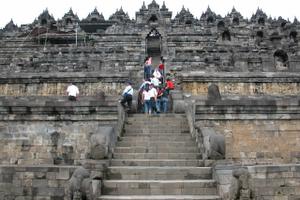 Early morning is the best time to visit Javanese temples, Borobudur
included. The gate opens at 6 am, around sunrise. The view of the
surrounding volcanoes and the Bukit Menoreh range to the south is
clearest at dawn, although morning mists sometimes obscure the view
until 8 am. Visitors must walk 500 meters to the base of the hill
then climb a series of steps to reach the temple foot. To see all
the reliefs one must walk more than 2 km (1.25 mile) around the four
galleries and climb several flights of steps. The minimum amount of
time needed at the Site is 1.5 hours.
Early morning is the best time to visit Javanese temples, Borobudur
included. The gate opens at 6 am, around sunrise. The view of the
surrounding volcanoes and the Bukit Menoreh range to the south is
clearest at dawn, although morning mists sometimes obscure the view
until 8 am. Visitors must walk 500 meters to the base of the hill
then climb a series of steps to reach the temple foot. To see all
the reliefs one must walk more than 2 km (1.25 mile) around the four
galleries and climb several flights of steps. The minimum amount of
time needed at the Site is 1.5 hours.
All in all, it was a highly enjoyable day out and I thoroughly recommend it.
Air Travel Illness
A review in the medical Lancet found the commonest diseases linked to air travel have been spread via contaminated food rather than from the cabin’s recycled air. The US researchers found a total of 41 in-flight outbreaks of food poisoning resulting in 11 deaths had been documented between 1947 and 1999. Salmonella was the most commonly reported infection spread by a commercial airline, with 15 recorded outbreaks between 1947 and 1999, affecting nearly 4,000 passengers and killing seven. The US authors stressed that no food- or water-borne outbreaks had been reported in the past five years probably because of greater use of pre-packaged frozen meals, and improved food handling and inspection.
Travel Writing Workshop
When: Saturday 18th June, 10.30am-4.00pm
Where: The Newsroom, The Guardian
60 Farringdon Road, London EC1R 3GA
Cost: £85.00
A day of two intensive workshops:
Travel Writing – How to do it and how not to with Dea Birkett, the Guardian’s Travelling with Kids columnist and author of Serpent in Paradise and Off the Beaten Track
Fact, Fiction and Creating a Traveller’s Tale with Rory Maclean, author of Falling for Icarus and Stalin’s Nose
The workshops are followed by practical writing sessions. Participants should bring pen and paper – they will be expected to write! The emphasis is – whether you are a beginner or already have some writing experience – on developing skills which can be applied to both articles and books. Our aim is that, by the end of the day, each of you will have the tools to produce a publishable piece of travel writing.
For further details and application form contact: travelworkshops@deabirkett.com
For further information:
- www.deabirkett.com
- www.rorymaclean.com
- www.guardian.co.uk/newsroom
The Maldives Background and Update
Scientists believe that Maldive Islands were first settled by Aryan immigrants who are thought to have colonised Sri Lanka at the same time, (around 500 BC). Further migration from South India, as well as Sri Lanka, occurred. The latest archaeological findings suggest the islands were inhabited as early as 1500 BC. Around 947 AD, recorded contact with the outside world began with the first Arab travellers. As the population increased, the Maldivian people with their mixed features formed tight-knit island communities. Historical remains dating back to 400 BC show strong evidence that Buddhism was widely practised among the people. Islam came to the Maldives with the Persian and Arab travellers and in 1153 AD Arabian traveller Abul Barakhat Al-Bar Bari is said to have been responsible for the conversion to Islam. In 1558, the Portuguese invaded and captured the Maldives. They ruled the country for 15 years, until Boduthakurufaanu, the national hero recaptured the Maldives from the Portuguese. He ruled the country as Sultan Mohamed Thakurufaanu from 1573 – 1583.
The Maldives became a British Protectorate and a dependency of Ceylon (Sri Lanka) in 1887 and remained so until 26 July 1965 when they gained full independence. The independent Maldives reverted from a Sultanate to a Republic on 11th November 1968 and since then the country has remained a fully independent republic.
The first resort, Kurumba Village was developed in 1972, on an uninhabited island near the capital, Malé. The resort, had accommodation for about 60 guests. The second resort was Bandos, with about 280 beds. The services in the two resorts were quite basic compared to that of others in the region. The food was mainly local and the transportation quite slow. It was also a time when air travel to the Maldives was only available on Air Ceylon which operated a small Avero aircraft. This plane carried only 48 passengers and took two hours to reach Malé from Colombo. Despite this, over a thousand tourists came to the Maldives in 1972. In 2003 the Maldives consists of more than 80 resorts, and over 500,000 visitors from all over the world. Italian visitors account for approximately 25% of all visitors, followed by the UK at 17%, Germany at 14% and Japan at 9% and the average stay is 8.5 nights.
The Maldives hold the record for being the flattest country in the world, with a maximum altitude of only 2.3 metres. Although there have been reports of rising sea levels threatening the islands, the sea level has actually lowered in recent decades. There are said to be 199 inhabited islands and 993 uninhabited islands.
The December tsunami reached the Maldives at approximately 9.20am on 26 December 2004, sending waves up to five metres high over the 1192 islands. The disaster is believed to have caused damage to 69 of the 199 inhabited islands and 14 islands are said to be completely devastated and had to be evacuated. In total, some 20,500 islanders were displaced from their homes and 83 people were killed, including three tourists. A further 25 people are still missing and presumed lost in the disaster.
Even before the disaster, environmentalists were concerned about the risk to the islands from rising sea levels. The most serious damage was to the islands along the east coast of the group, particularly in North Malé Atoll and South Malé Atoll, but the capital, Malé, and the international airport on Hulhule island experienced only minor flooding. The tsunami also caused significant damage in the far south of the Maldives, particularly to Vilufushi in the Thaa Atoll and Kolhufushi in the Meemu Atoll. In the north, Kandholhudhoo island in the Raa Atoll was completely destroyed, displacing 3,000 islanders from their homes. The island has since been abandoned. Cartographers are planning to redraw the maps of the islands due to alterations by the tsunami.
Despite the massive damage to homes, schools, harbour facilities, telephone and electricity suppliers and general infrastructure, the loss of life was thankfully comparatively small, especially when compared with Indonesia, Sri Lanka, India and Thailand. Still, estimates suggest that around 7% of the population has been left homeless by the disaster and the overall cost of damage is estimated at US$470 million, or 62% of the islands' GDP. The government has reported that the impact of the tsunami will set back development in the Maldives by two decades.
Despite this, the emergency relief effort has been extremely successful, though some would say that it has been challenged to the areas most frequented by tourists. As of March, 71 of the 87 resorts in the Maldives were open as normal and tourists could visit Malé and other areas that escaped major damage without problems. However, 16 resorts remain closed as a result of the disaster – for an update on the 16 hotels that are closed, see: www.visitmaldives.com.mv
No prior visa arrangements are required, but some requirements must be fulfilled to obtain a 30 days tourist visa on arrival: a visitor must have a valid travel documents and properly completed embarkation/disembarkation cards which usually provided at during the inward flight. In addition, visitors must also have a return air ticket or at least US$ 50.00 per intended day of stay in Maldives. Any amount of Foreign currency can be brought in without declaring and can be taken out without any restriction. Some items are forbidden to be imported to the country, including firearms and explosives, pornography of any kind, including what would be considered “acceptable erotica” in all western (and most eastern) societies, pork and all products containing pork, narcotic drugs, poisons and hazardous, irritable or industrial chemicals and alcohol. Alcoholic items purchased on the trip will be held in Customs bond for collection upon departure.
Get Health Advice
The Health Protection Agency say that tourists need more advice about how to protect their health while they are away. They say, while many companies do tell travellers to get health advice about their destination, others do not. But a spokesman for the Association of British Travel Agents (ABTA) said members did offer advice if people were travelling to more exotic destinations. Up to 2,000 Britons die abroad each year, most of them from natural causes, according to figures from the HPA.
Have you got a tale to tell?
If you have a travellers tale that your aching to tell. Then why not visit the “Travel Sized Bites” section of the Website and share it with the world. Travel Sized Bites
The Maldives Tourist Info by Muaz Adnan
Scattered across the equator across the Indian Ocean, the pearl like islands of the Maldives depicts the rare vision of a tropical paradise. Palm fringed islands with sparkling white beaches. Turquoise lagoons, clear warm waters and corals reefs teeming with abundant varieties of marine fauna and flora, continue to fascinate visitors as it has fascinated other in past, for thousand of years. Marco Polo referred to the Maldives as the flower of the Indies and Ibn Batuta referred to the Maldives as one of the wonders of the world.
Truly a natural wonder, the height of the islands rarely reach above two metres. The 1,192 islands consist of 27 atoll formations, spread over 90,000 square kilometres. The Maldive atolls are a classic discovery in their own right: the word atoll is derived from Dhivehi, the Maldivian language, from the word atholhu.
The islands are surrounded by shallow crystal clear lagoon enclosed by coral reefs. The unique islands provide visitors with one of the most breath taking views of underwater life in the world. Formed above peaks emerging from the depths of the ocean, upon layers of both living and dead coral, and remnant of other marine life, the islands are generally covered with dense tropical vegetation. Coconut palms towering above dense shrubs and hardly plants protecting the shores from erosion are natural features in most islands. These islands together embody living entities in various stage of formation. As interdependent elements in ecology, in a food chain where birds, fish and other marine life co-exist, with humans at its apex as caretakers for centuries.
Measuring 820 kilometres north to south and 120 kilometres east to west at its greatest width, the closest neighbours are India and Sri Lanka. With a population 270,110 ( 2000 official estimate), only 199 islands are inhabited 87 islands are set aside exclusively for tourist resort development.
There are plenty of things to do in the Maldives. You can take a diving safari where you can visit inhabited islands (fishing villages), resorts and uninhabited islands. Even if you are not a diver, or a honeymooner, there are cultural shows, excursions to Malé, night fishing, barbecues (subject to weather and length of stay) to keep you entertained. It is possible to visit a local inhabited island and see their simple life style in harmony with nature also you will get the opportunity to see some of the typical daily chores carried by the simple island forks while other maybe involved in building a wooden local dhoni boat or weaving rope etc.
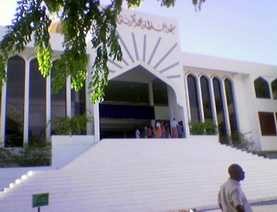
Sultan Mosque
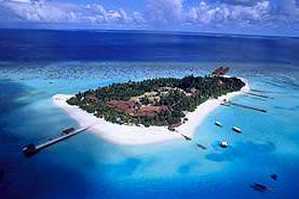
A typical resort, this one is the Laguna Beach Resort
Some people like the big game fishing and night fishing where you can usually go to an uninhabited island to have a barbecue after the fishing.
If you are interested in visiting the Maldives, Mr Muaz Adnan would be only too happy to advise you and make any travel arrangements and bookings for you. He can be contacted by e-mail on: muazadnan2002@yahoo.com
Satellite Pics
Google, the search engine can help you access satellite photos of North America’s most significant landmarks and locations, including the Grand Canyon, Alcatraz and Mount Rushmore. You need to enter in a zip code and a photo from space of that location – if available – is then shown. At the moment Google only offers satellite images of locations in the US and Canada but Keyhole Corporation, which Google bought last year has data for the whole globe so the service could be rolled out for other countries. The detail in some of the Google photos is impressive – putting zoom at the highest level lets you pick out individual houses and even cars. The catch? There’s a fee to use the service though a free 7 day trial is available. See:
Cockroach Trivia
The Beetle has bad memories about sharing a room with what seemed like a thousand cockroaches in Gilgit in Pakistan a few years ago and was afraid that they would fly on to her bed. (Before you ask, no, Beetles are not friends with cockroaches, they are sworn enemies, but we try and live and let live.)
Did you know that most cockroaches have wings, but they can only fly when temperatures are quite high. And what’s more, cockroaches are omnivorous, i.e. they will eat anything, including each other if there is nothing else available.
One internet source, maybe urban myth, states that a cockroach can live up to nine days without its head before it starves to death. They have amazing scuttling abilities: one US study showed that cockroaches are capable of running at 50 body lengths per second on a treadmill – the equivalent of Carl Lewis doing the 100-meter in 1.09 seconds!
Interesting Facts
Interesting Facts
- Aussies picked up the most medals each at the Sydney Olympics, which brings them into the all time top 11.
- Finns are perhaps the world's greatest athletes, ranked first at summer Olympics and third in winter games.
- Almost half of Ecuador is protected.
-
Kenyan women
work 35% longer than their men folk.
- Ethiopians are by far the most agricultural people on earth (both men and women)
- Looking for Czech and Slovak men? Half are in factories.
- American women have the most powerful jobs.
- Southern European women hugely outnumber their men folk amongst the unemployed.
- The top 8 most developed countries all speak Germanic languages. Every such country is in the top 20.
- Belgium is the only country in the world where women dominate the ministry.
Source: www.nationmaster.com
Macchu Picchu
Unesco has warned Peru that the Inca citadel of Machu Picchu might lose its world heritage status if they do not act to protect it. Every year, hundreds of thousands of people visit Machu Picchu. Experts say unrestricted tourism and landslides have damaged the 15th Century citadel and the nearby Inca trail that leads to it. In response, the Peruvian authorities have submitted a 400-page report $130m plan to the UN’s cultural arm which is believed to include satellite monitoring to measure earth movements and a daily limit of 2,500 tourists, to preserve the site.
Ignominy for Beetles
Whilst we are talking about insects: spotted by webmaster Paul, US Entomologists Quentin Wheeler and Kelly B. Miller recently had the task of naming 65 newly discovered species of slime-mold beetles and named three species after the US president George W Bush, vice president Dick Cheney and defence secretary Donald H Rumsfeld. The newly found beetles are respectively called: Agathidium bushi Miller and Wheeler, Agathidium cheneyi Miller and Wheeler, and Agathidium rumsfeldi Miller and Wheeler. Naming the beetles after Bush, Cheney and Rumsfeld was intended to pay homage to them, said Wheeler, who taught at Cornell University for 24 years and now is with the Natural History Museum in London.
A Little Part of Istanbul
When Sultan Mehmet the Conqueror took over Istanbul in 1453, he first ordered the construction of a new palace for this new Ottoman capital, on a site in the district of Beyazit where Istanbul University stands today. Then he changed his mind and had a number of buildings constructed on the headland which was an olive grove to the southeast. It is these buildings that became the Topkapi Palace. The Topkapi Palace was the home to all the Ottoman sultans until the reign of Abdulmecid I (1839-1860), a period of nearly four centuries. The final form of the first palace covered an area 700m², and was enclosed with fortified walls 1400 meters in length. The walls had a number of gates, namely the Otluk gate, the Demir gate and the Imperial Gate and a number of minor angled gates between them. After the reign of Mehmet, the palace grew steadily to form a city like complex of buildings and annexes, including a shore palace known as the Topkapi shore palace, as it was situated near the cannon gate -Topkapi- of the ancient walls of Istanbul. When the shore palace was burned down in 1863, it lent its name to the great complex we now know as Topkapi Palace.
The Topkapi Palace continued to be the principal residence for four centuries until in 1853, Sultan Abdul Mecid I moved into the new palace of Dolmabahce on the Bosphorus. The old palace was used as house for the women of the departed sultans and their servants until the Harem was officially disbanded in 1909. In 1924, Topkapi Palace was converted to a museum on instructions of Mustafa Kemal Ataturk. The final step was the opening of the Harem to the public in 1960.
Because Topkapi is the first attraction to tick off on everyone's list get there when it opens, so get there early. The Topkapi Palace Museum is open between 9:00 am-5:00 pm everyday except for Tuesdays. Tickets can be purchased in the gateway to the Second Court. The tickets cost 12.000.000 TL. (equivalent to about 8 USD or 7 EUR) per person. The treasury section needs a separate admission fee and costs 10.000.000 TL. There is a discounted fee for the students. The Harem Section can be visited with a separate ticket in the ticket office near the Harem entrance. The tours to Harem are operated every half hour from 9:30 am to 4:00 pm. The tickets cost 15.000.000 TL(11 USD or 9 EUR).
Go straight to the Harem, which can only be seen by guided tour, as the tours fill up early. After the Harem tour you can stroll around the palace's grounds and the four courtyards at your leisure. Also, don't miss the Treasury in the 3rd courtyard which houses gold, and works of art.
Straight after the Topkapi Palace, head for the Aya Sofia and the Blue Mosque which are virtually next door.
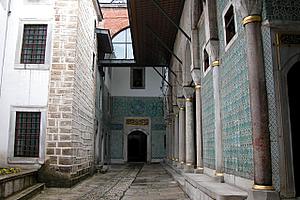
Courtyard of the Eunuchs
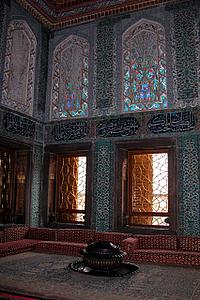
A room in the harem
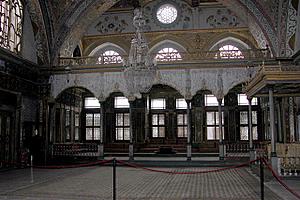
Topkapi Imperial Hall, Harem
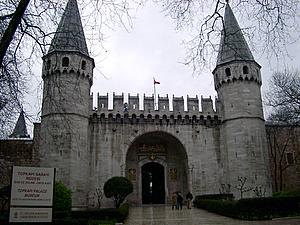
Topkapi Gate
New Resting Place for Nelson's Sailors
The bodies of 30 British soldiers and sailors and their families, who died during Nelson’s Nile campaign more than 200 years ago were discovered on the small island by an Italian archaeologist looking for Greek and Roman artefacts. The old graves were in danger of being washed away as the sea eroded the island. The remains were reburied at the Military and War Memorial Cemetery at British families cemetery, Al-Shatby in Alexandria with full families honours during a recent ceremony. One of the dead’s descendent Gordon Watson, 87, from Hampshire, and his 83-year-old wife, Joan, travelled to Egypt for the ceremony. After the ceremony, Mr Watson said: “It’s marvellous to be related to this man … It makes you proud to be English.”
Gettysburg a Civil War Battlefield by Susan Velasquez
A visit to Gettysburg will take you back in time, where you can almost hear the ghosts of the civil war soldiers and, louder still, the cannons still bursting in air.
The immense area must be covered by bus or private car. Get a map at the information centre and then follow the route around the site. When you arrive at a site that you want to take a closer look at there are plenty of parking areas or simply stop the car on the side of the road as they have wide shoulders. Each battlefield has a plaque explaining the regiments that fought there, and details such as the dates and the number of casualties. You will be moved by the number of huge monuments dedicated to the soldiers from each state and by the passionate wording and sheer numbers of dead from the various battles.
After viewing these monuments and (through a local guide) hearing or reading about what took place there, you can almost feel what it must have been like to be a young soldier thrown into battle, only to be slaughtered by the other side. It really brings home the horrors of war and the incredible courage of the men fighting them. The fact that now these places are lovely and peaceful fields that have been preserved in their memory is moving. Unfortunately though, not all the fields are being saved as the modern world is slowly crowding in on the area. Motor vehicle dealerships and commercial buildings are taking over some of the fields there, which is an absolute shame.
You can also spot wild life in some spots, like a group of deer that we came across. The deer are so used to the cars that they won't stop before crossing roads. So you have to drive slowly and carefully, especially when turning corners. In a particularly graphic field, there is still an old house that was bombed during one of the battles and still has a large hole in the front, which clearly shows the dangers of living in the area at the time. A guide explained that in a nearby field there was basically a total slaughter of the soldiers and the field was littered with bodies, and the stench could be smelled for weeks. There are also tales of ghosts being seen in the area at night as well as strange noises.
So for a truly moving experience and a lesson on one of the more unflattering periods in American history, visit Gettysburg, Pennsylvania.
Snails Big Business in Bosnia
Did you know that there are estimated to be around 300 snail farms in former war torn Bosnia? One kilogram of snails is sold for four around euros (£2.70). France is the number one export destination, followed by Italy. The aim is for a snail farmer to produce around 3,000kg of snails in a year. That means an annual income of around 12,000 euros (£8,100) – around four times the national average wage. The British chief international envoy to Bosnia, Lord Ashdown, has made a priority of trying to encourage small businesses. He set up a so-called “Bulldozer” committee to smash through the red tape and old-style communist legislation that hindered the setting up of new companies. “Small and medium-size firms, like snail farms, represent the future of this country rather than the old pre-war industries, which are not coming back,” says Vedran Persic from Lord Ashdown’s office.
